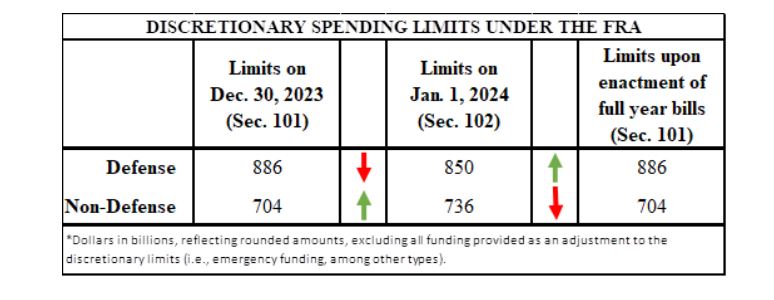OMB pushes 1% discretionary sequestration requirement off
The Office of Management and Budget detailed to agencies in new FAQs why the short-term continuing resolution will not require cuts as called for under the Fisc...
Agencies don’t have to worry about a 1% sequestration on discretionary funds kicking in for a few more months.
The Office of Management and Budget says the requirement to reduce discretionary spending under the Fiscal Responsibility Act (FRA), signed into law in June, wouldn’t take effect until “after full year appropriations are enacted, or April 30, whichever comes first.”
“OMB will take no action on Jan. 1, 2024, and no additional action should be taken by agencies to reduce impacted discretionary funding, even though a short-term continuing resolution will be in effect at that time,” OMB wrote in frequently asked questions on 2024 discretionary spending sent to agencies on Dec. 22. “If any discretionary appropriation account remains on a short-term CR past April 30, OMB is required to issue a final sequestration report that compares the annualized appropriation levels provided by all discretionary appropriations bills under current law as of April 30 against the [FRA’s] section 102 interim spending limits. A breach of the section 102 spending limits would require OMB to order a sequestration to bring the current law discretionary appropriations in line with those interim spending limits.”
Section 102 creates an alternative interim spending limits for discretionary budgets with cuts of 1% to the defense and non-defense budgets.

President Joe Biden signed the FRA into law on June 3, which set discretionary spending limits for fiscal years 2024 and 2025. The bill matches Biden’s proposed defense budget of $886 billion and allots $704 billion for nondefense spending, but also requires Congress to approve 12 annual spending bills or face a snapback to spending limits from the previous year, which would mean a 1% cut.
Congress averted a shutdown, but didn’t complete the passage of all 12 spending bills by Dec. 31.
Biden signed the continuing resolution on Nov. 17, keeping some federal agencies funded through Jan. 19, while others would be funded through Feb. 2, creating two dates when there will be a risk of a partial government shutdown.
OMB determined the FRA’s mandated 1% discretionary cut would not impact the short-term CR and “agencies should continue to operate as they normally would and as directed by OMB Bulletin 23-02, Apportionment of the Continuing Resolution(s) for Fiscal Year 2024, if applicable.”
“A switch to the section 102 interim spending limits does not mean that OMB will order a sequestration to reduce funding available to agencies on Jan. 1. Agencies should not attempt to self-sequester and must continue as normal unless OMB orders a sequestration. Note that the 1 percent that is often cited refers to the calculation OMB would use to determine the interim spending limits in section 102 of the FRA, not the amount of funding that would need to be sequestered. This percentage has yet to be determined,” OMB stated. “The amount by which total discretionary spending for defense or non-defense would exceed the discretionary spending limits depends on what is included in future legislation. Thus, the sequestration percentage is unknown at this time.”
OMB says it will make the decision to order a sequestration within 15 days of the final 2024 spending bills becoming law or after April 30.
“Once Congress completes the enactment of full-year appropriations, the interim spending limits will revert back to the section 101 levels, even if that occurs after April 30. At that time, OMB will determine whether or not the total discretionary funding in either the defense or non-defense category exceeds the section 101 discretionary spending limits and whether a sequestration is required. OMB is required to make this determination even if a Final Sequestration Report was already issued on April 30,” OMB stated.
The Congressional Research Service came to a similar conclusion as OMB in a November report on how the CR would impact the discretionary spending caps.
Agencies haven’t faced a sequestration order since 2013 when the Obama administration cut discretionary spending by about $85 billion in 2013, which ended up being about a 7.8% cut to Defense agencies and a 5% cut to civilian agencies.
In 2013, OMB issued a memo that included more specifics for how to cut discretionary spending. But because the 2024 cuts potentially would be a significantly less, the steps agencies would have to take would be less intrusive.
Copyright © 2024 Federal News Network. All rights reserved. This website is not intended for users located within the European Economic Area.
Jason Miller is executive editor of Federal News Network and directs news coverage on the people, policy and programs of the federal government.
Follow @jmillerWFED






